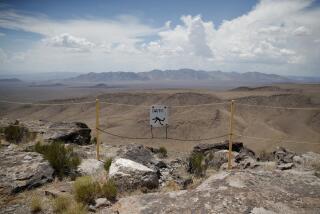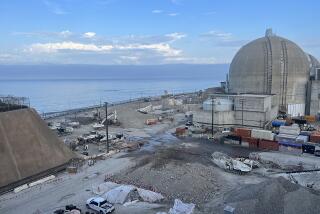Charleston Port Doesn’t Want Reactor Either
- Share via
Southern California Edison got more bad news Friday: Officials in South Carolina, citing security concerns, announced they will not allow a decommissioned nuclear reactor from the San Onofre Nuclear Generating Station to sail into the Charleston port.
The decision is the latest obstacle for transporting the massive reactor to Barnwell County, S.C., the only place in the nation that Southern California Edison can dispose of the 950-ton chunk of radioactive steel and concrete.
On Thursday, the company acknowledged that the Panama Canal Authority has denied passage through the 50-mile waterway, Caltrans won’t allow it on the San Diego Freeway, and Burlington Northern Santa Fe refuses to move it by rail unless the company is absolved of liability, a step Edison will not take. In addition, environmentalists might sue next week to stop Edison’s plan to haul the reactor across eight miles of sandy beach to start the journey.
On Friday, officials said that in light of heightened terrorism concerns, it is too dangerous to move a radioactive reactor through the Port of Charleston.
“Quite frankly, with the high alert, there is a general concern” that terrorists could somehow gain control of the radioactive material, said Anne Moise, vice president of the port. “We don’t feel it’s appropriate at our port at this time. They would have to find other facilities.”
The port authority also sent a letter Friday to the company that operates the terminal where a barge bearing the reactor was supposed to dock to unload. Charleston International Ports LLC, which has a contract with Southern California Edison, was informed that handling the reactor violates its lease, which forbids the company to come in contact with hazardous materials.
Edison officials, who said they were unaware of a problem in South Carolina, declined to comment on the port announcement. But spokesman Ray Golden said the company examined a number of ports in the area, and Charleston was the only one suited to receive the reactor.
The series of obstacles creates a problem for Edison, which is required under terms of its federal license to dispose of the decommissioned reactor to a nuclear waste facility. The company is faced with a diminishing number of very expensive options.
If the company cannot persuade Panama to open its canal, it might be forced to sail a barge around the tip of South America or even around the world to reach the East Coast. And if it cannot find a port to accept the cargo, Edison might be compelled to ship the reactor by train, somehow overcoming the objections of railroads and countless communities through which the load would travel.
The problem of transporting and storing nuclear waste that will be radioactive for hundreds of years is a pressing issue not limited to San Onofre. There are more than a dozen nuclear power plants being decommissioned across the nation.
Disposing of low-level radioactive waste like the reactor is also only a preview of more difficult disposal issues.
There’s no place in the nation to dispose of spent nuclear fuel, which will be highly radioactive for thousands of years. The depleted uranium sits in storage at San Onofre and plants across the nation, awaiting the opening of a repository at Yucca Mountain in Nevada.
Residents in Nevada and South Carolina object to becoming the nation’s dumping ground for radioactive waste.
“This is really not safe, and it’s all the more inappropriate to take waste generated on the other side of the country and manage it in a community that didn’t receive any benefit from it,” said Bob Guild, a environmental lawyer in Columbia, S.C., and Sierra Club board member. “We’re so used to being dumped on it’s just sort of par for the course. South Carolina has been the path of least resistance for everyone’s worst nasty stuff, including nuclear waste.”
Daniel Hirsch, director of the nuclear watchdog group Committee to Bridge the Gap and former director of the Adlai Stevenson program on nuclear policy at UC Santa Cruz, said the utilities should have foreseen such transportation and long-term disposal problems when they built the nation’s 103 power plants.
“The nuclear geniuses were like the people who painted themselves in a corner without thinking how they were going to get out,” he said. “This is a little taste of the world these people have forced us to inherit.”
More to Read
Sign up for Essential California
The most important California stories and recommendations in your inbox every morning.
You may occasionally receive promotional content from the Los Angeles Times.











